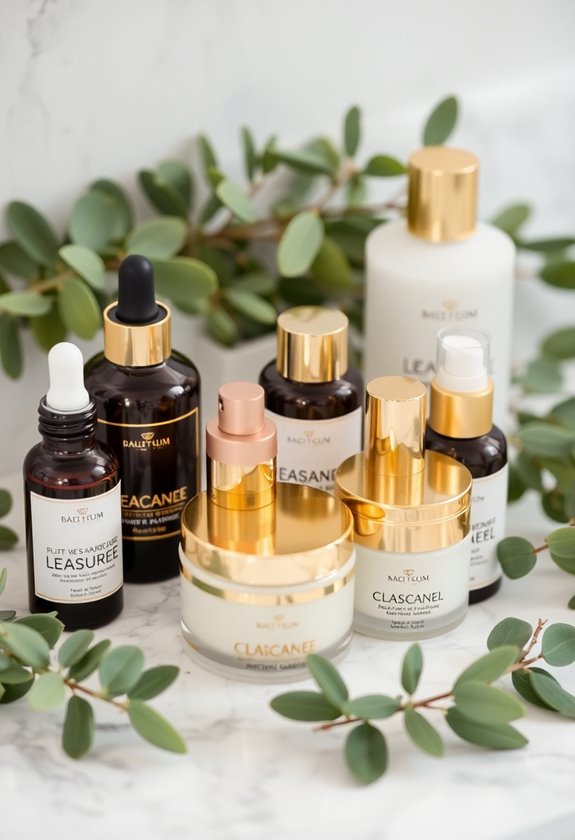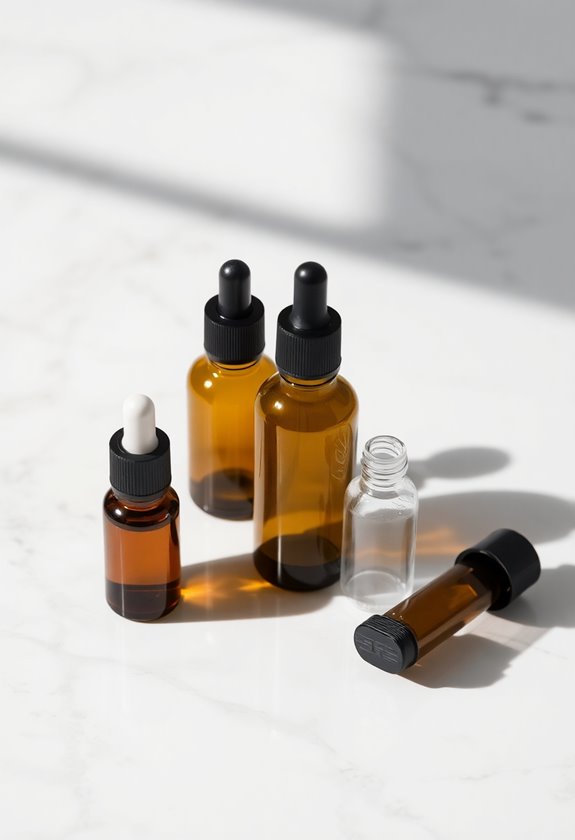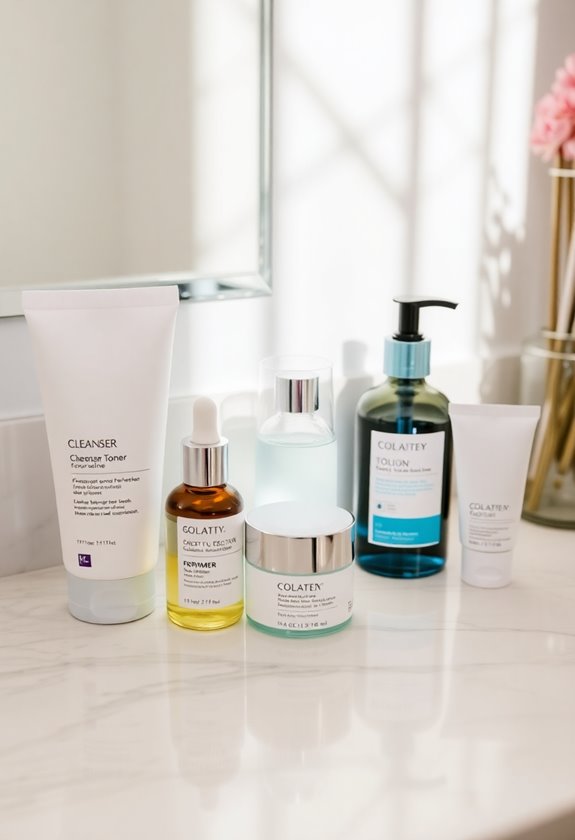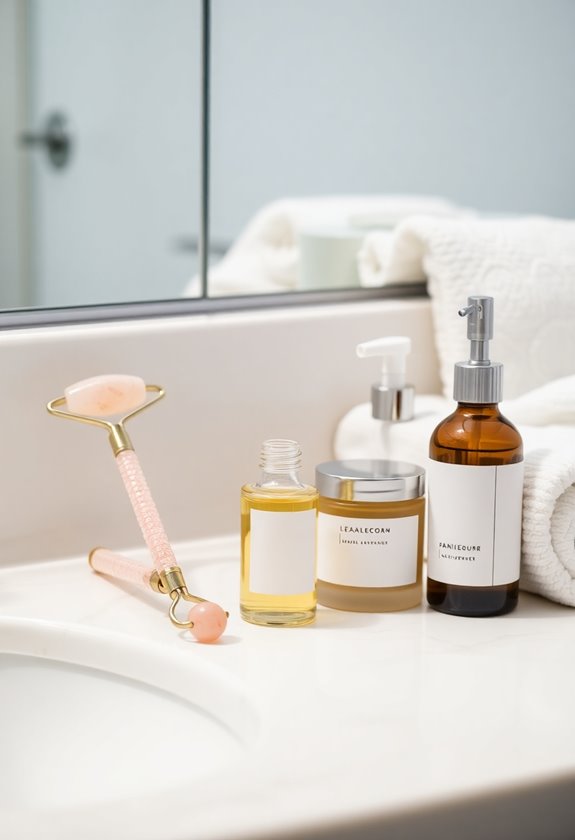Transform your dry skin with this simple yet powerful 3-step morning routine. Start by cleansing with a gentle, fragrance-free cleanser and lukewarm water to preserve your skin's natural moisture barrier. Next, apply a hydrating serum containing hyaluronic acid to damp skin, focusing on areas that need extra moisture. Finally, lock everything in with a nourishing moisturizer enriched with ceramides and glycerin while your skin is still slightly damp. This science-backed sequence helps prevent moisture loss throughout the day, supports your skin's protective barrier, and promotes long-term hydration. Understanding the key ingredients and techniques will help you maximize these benefits.
Highlights
- Start with a gentle, cream-to-foam cleanser using warm water to protect the skin's natural moisture barrier.
- Apply a hydrating serum containing hyaluronic acid immediately after cleansing while skin is still slightly damp.
- Finish with a rich moisturizer containing ceramides and glycerin to lock in hydration and protect against moisture loss.
- Protect skin from UV damage by applying broad-spectrum sunscreen as the final step before makeup application.
- Keep morning cleansing brief and use lukewarm water to prevent stripping natural oils from dry skin.
Why Proper Morning Skincare Matters
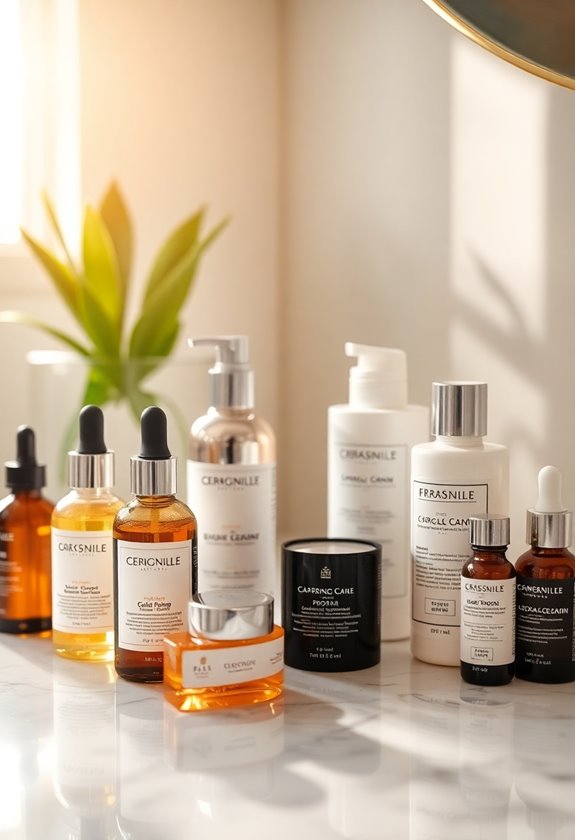
Like a protective shield for your skin, a proper morning skincare routine is essential for those with dry skin. You're not just pampering yourself; you're creating a significant barrier against environmental stressors that can damage your skin throughout the day. A quality vitamin C serum helps brighten and protect your complexion while fighting free radical damage.
Your morning routine helps maintain your skin's natural pH balance and protective barrier, which is important for preventing moisture loss and keeping your skin hydrated. Taking just a few minutes daily can make a remarkable difference in your skin's health. You'll notice that when you follow a consistent morning regimen, your skin becomes more resilient against external factors like UV rays and pollutants that can cause premature aging. By preparing your skin properly each morning, you're also creating an ideal canvas for makeup application while reducing the risk of irritation, dryness, and other common skin concerns that can affect dry skin types.
Common Dry Skin Challenges

Living with dry skin presents several daily challenges that can affect both your comfort and appearance. You'll likely notice your skin feeling tight and itchy throughout the day, while visible flaking or scaling can make you feel self-conscious, especially if you have darker skin tones.
Without proper care, these challenges can escalate into more serious concerns you'll need to address. Your skin's protective barrier may become compromised, leading to increased vulnerability to infections, particularly when skin cracks or bleeds. If you're scratching frequently, you're at risk of developing permanent skin changes, including discoloration and thickened patches. Indoor heat sources can intensify these dryness problems significantly. Using a skincare fridge can help soothe irritated dry skin and enhance the effectiveness of your moisturizing products. What's more, if you're already dealing with conditions like eczema or psoriasis, dry skin can trigger flare-ups that make these conditions considerably worse.
Step One: Gentle Cleansing

Your morning skincare routine begins with gentle cleansing, an essential step that sets the foundation for healthy, balanced skin. When choosing your cleanser, look for fragrance-free, soap-free formulas that won't strip away your skin's natural moisture barrier.
For best results, opt for a cream-to-foam cleanser with hydrating ingredients like hyaluronic acid and glycerin, such as CeraVe Hydrating Cream-to-Foam Cleanser or Cetaphil Gentle Skin Cleanser. Use warm water to wash your face, as hot water can further dry out your skin, and keep your cleansing time brief to prevent moisture loss. Once you've finished cleansing, don't wait to apply your moisturizer – it's most effective when your skin is still slightly damp, helping to lock in essential hydration. This step is particularly crucial as declining sebaceous gland function can make dry skin worse over time.
Step Two: Hydrating Serum Application
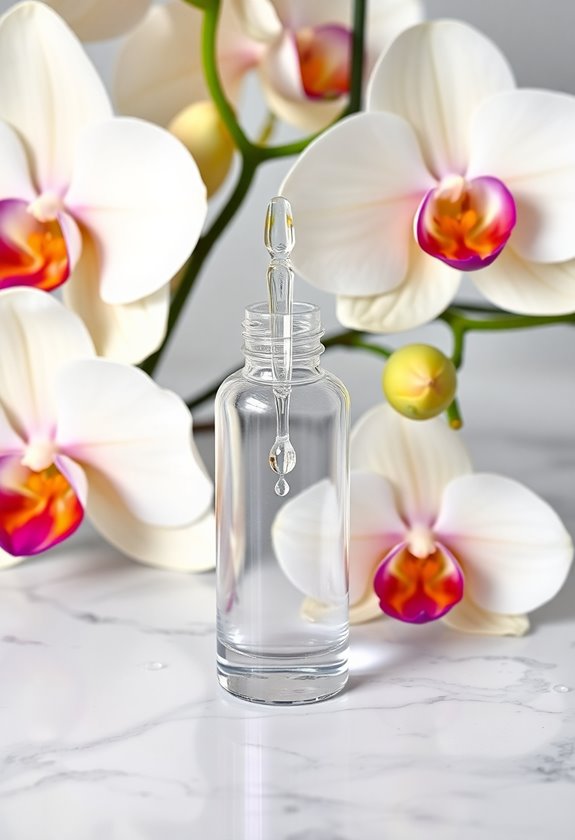
After cleansing your face, the next step focuses on deep hydration with a targeted serum. You'll want to choose a serum containing hyaluronic acid with multiple molecular weights, as this provides ideal moisture retention at different skin layers.
Apply two pumps of serum to your clean, dry skin, gently patting it across your face while avoiding the eye area. Hyaluronic acid can retain 1000x water compared to its own weight, making it exceptionally effective for dry skin. For enhanced benefits, look for formulations that combine hyaluronic acid with ingredients like ceramides, peptides, and natural antioxidants. Don't worry about dampening your skin first – contrary to popular belief, hyaluronic acid works effectively on both wet and dry skin surfaces. The serum's water-based formula contains enough moisture to help these ingredients bind effectively, creating a lightweight yet powerful hydrating layer that's perfect for your dry skin. For an extra boost of hydration, consider using a hydrating face mask once or twice per week after applying your serum.
Step Three: Lock In Moisture

Locking in moisture stands out as the most essential step for managing dry skin effectively. You'll want to select a rich cream or ointment that contains powerful hydrating ingredients like hyaluronic acid, ceramides, and glycerin to seal in moisture and protect your skin barrier.
Apply your moisturizer while your skin's still slightly damp from your hydrating serum, using gentle circular motions to guarantee even distribution across your face and neck. It's best to keep your bathroom door closed to trap humidity while performing your skincare routine. Don't forget to pay special attention to the delicate area around your eyes, where dryness often appears first. For best results, you'll need to use enough product to fully cover your skin without feeling heavy, and if you're heading outside, make sure your moisturizer contains at least SPF 15 for added protection.
Additional Morning Skincare Tips

Successfully managing dry skin requires more than just following basic steps – it's about mastering the finer details of your morning routine. You'll want to apply your products while your skin is still damp from cleansing, which helps lock in precious moisture throughout the day.
When choosing products, look for gentle cleansers labeled "hydrating" and avoid anything that might strip your skin's natural oils. You'll need moisturizers containing hyaluronic acid and glycerin, while serums with niacinamide and ceramides will help rebuild your skin barrier. Remember to pat your serums into your skin instead of rubbing, and always apply eye cream with a gentle dabbing motion. Don't forget to finish with a broad-spectrum sunscreen of at least SPF 15 to protect your skin from UV damage. For optimal hydration results, consider using facial moisturizers that contain multiple active ingredients to achieve that coveted glowing complexion.
Best Ingredients To Look For
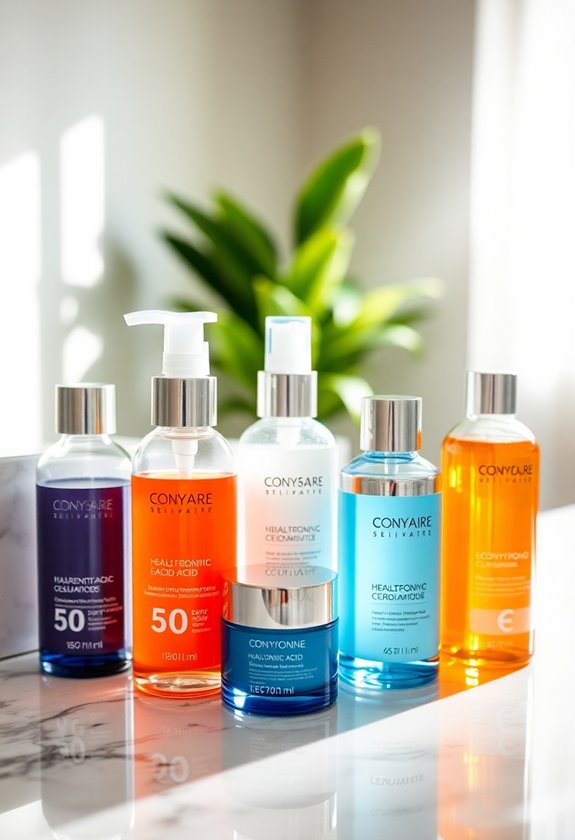
Building an effective skincare routine starts with selecting products that contain the right ingredients for dry skin. You'll want to focus on ingredients that both hydrate and lock in moisture, while also supporting your skin's natural barrier function.
- Look for hyaluronic acid and glycerin in your toners and serums, as they're powerful hydrators that draw moisture into your skin
- Choose moisturizers containing ceramides and squalane, which help prevent water loss while maintaining your skin's protective barrier
- Include products with niacinamide to boost hydration and reduce inflammation while strengthening your skin's natural defenses
- Select formulas enriched with shea butter and avocado oil for deep nourishment, especially in your night cream
These ingredients work together to combat dryness and create a healthy, hydrated complexion that feels comfortable throughout the day.
What To Avoid

While caring for dry skin requires the right ingredients, it's equally important to
Building Long-Term Skincare Success

The journey to healthy, hydrated skin requires more than just a collection of products – it demands a strategic, long-term approach. You'll need to commit to consistent routines, understand your skin type, and focus on preventative care while maintaining realistic expectations about results.
To build lasting skincare success, incorporate these essential practices:
- Establish a simplified yet effective routine focusing on cleansing, moisturizing, and sun protection that you'll actually follow every day
- Give your products time to work by maintaining consistency for at least two months before evaluating results
- Choose multipurpose products with proven ingredients like hyaluronic acid and ceramides rather than chasing trendy brands
- Complement your skincare with healthy lifestyle habits, including proper hydration, balanced nutrition, and stress management
Remember to seek professional guidance when needed and stay patient as you work toward your skincare goals. Consider incorporating facial oils into your routine for an extra boost of nourishment and radiance.
Frequently Asked Questions
Can I Skip Morning Cleansing if I Thoroughly Cleaned My Face Last Night?
Yes, you can skip morning cleansing if you've properly cleaned your face the night before, especially if you have dry skin. Instead, you can simply splash your face with lukewarm water to refresh it. Your skin produces natural oils overnight that help maintain its moisture barrier, and over-cleansing can strip these beneficial oils, potentially leading to increased dryness and irritation.
Should I Apply Moisturizer While My Skin Is Still Damp or Completely Dry?
Studies show that applying moisturizer to damp skin can increase hydration levels by up to 40% compared to dry application. You'll want to apply your moisturizer while your skin is still slightly damp, as this helps trap moisture and allows for better product absorption. The American Academy of Dermatology backs this approach because moisturizers contain occlusives that work more effectively when they can seal in existing water on your skin's surface.
How Long Should I Wait Between Applying Each Skincare Product?
You don't need to wait long between skincare products, but giving each layer 1-2 minutes to absorb can be beneficial. Apply your products from thinnest to thickest consistency while your skin is slightly damp from cleansing. If you're using active ingredients like vitamin C or retinol, allow these to absorb for 2-3 minutes before your next product to guarantee maximum effectiveness.
Is It Necessary to Use Different Products in Summer Versus Winter?
Yes, it's crucial to adjust your skincare products seasonally because your skin's needs change considerably with the weather. During summer, you'll want to switch to lighter, gel-based products that won't clog pores while maintaining hydration. In winter, your skin requires richer, more nourishing products to combat dryness and protect against harsh conditions, so you should opt for creamier moisturizers and barrier-supporting ingredients.
Can I Mix Multiple Serums Together to Save Time?
While mixing serums might seem as tempting as creating your own skincare cocktail, it's not recommended to blend them in your palm before applying. Instead, you'll want to layer them one at a time to guarantee each serum's active ingredients work effectively. You can still use multiple serums in your routine by applying them separately, starting with the thinnest consistency and waiting 30-60 seconds between each application.

